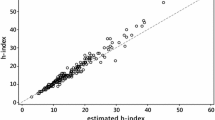Abstract
The ratio of the total number of citations to the total number of cited papers was called “Garfield’s Constant” in some of the earlier works of Eugene Garfield. Later, he himself realized that the ratio is changing over time, but still was confident that behind this ratio some deeper regularity may be found. In the present paper a systematic analysis of this indicator, the Garfield Ratio is attempted. Its application in journal-level analysis is presented.






Similar content being viewed by others
References
Alonso, S., Cabrerizo, F. J., Herrera-Viedma, E., & Herrera, F. (2009). h-Index: A review focused in its variants, computation and standardization for different scientific fields. Journal of Informetrics, 3(4), 273–289.
Andreis, M., & Jokic, M. (2008). An impact of Croatian journals measured by citation analysis from SCI-expanded database in time span 1975–2001. Scientometrics, 75(2), 263–288.
Bensman, S. J. (2007). Garfield and the impact factor. Annual Review of Information Science and Technology, 41(1), 93–155.
Braun, T., Glänzel, W., & Schubert, A. (2005). A Hirsch-type index for journals. Scientist, 19(22), 8.
Braun, T., Glänzel, W., & Schubert, A. (2006). A Hirsch-type index for journals. Scientometrics, 69(1), 169–173.
Braun, T., Glänzel, W., & Schubert, A. (2010). On Sleeping Beauties, Princes and other tales of citation distributions. Research Evaluation, 19(3), 195–202.
Garfield, E. (1972). Citation analysis as a tool in journal evaluation. Science, 178, 471–479.
Garfield, E. (1976). Is the ratio between number of citations and publications cited a true constant? Current Contents, #6, 5–7. Reprinted in: Garfield, E. (1977) Essays of an Information Scientist, 2, 419–425.
Garfield, E. (1990) Journal Citation Studies. 52. The multifaceted structure of crystallography research. Part 2. A global perspective. Current Contents, #37, 3–11. Reprinted in: Garfield, E. (1990) Essays of an Information Scientist: Journalology, KeyWords Plus, and other essays, Vol 13, pp 337–345.
Garfield, E. (1998). Random thoughts on citationology. Its theory and practice. Scientometrics, 43(1), 69–76.
Holden, G., Rosenberg, G., & Barker, K. (2005). Tracing thought through time and space: A selective review of bibliometrics in social work. Social Work in Health Care, 41(3/4), 1–34.
Institute for Scientific Information. (1971). Science Citation Index 1970: Guide & Journal Lists (p. 14). Philadelphia: Institute for Scientific Information.
Institute for Scientific Information. (2001). Science Citation Index 1995–2000: Comparative statistical summary. Philadelphia: Institute for Scientific Information.
Kolasa, W. M. (2012). Specific character of citations in historiography (using the example of Polish history). Scientometrics, 90(3), 905–923.
Luukonen-Gronow, T., & Suutarinen, P. (1988). Bibliometric analysis of Nordic cancer research: a report on study data. FPR-Publication No. 8. Copenhagen: Nordic Council of Ministers.
Rushton, J. P., & Endler, N. S. (1979). More to-do about citation counts in British psychology. Bulletin of the British Psychological Society, 32(March), 107–109.
van Leeuwen, T. (2012). Discussing some basic critique on Journal Impact Factors: Revision of earlier comments. Scientometrics, 92(2), 443–455.
Vinkler, P. (2000). Evaluation of the publication activity of research teams by means of scientometric indicators. Current Science, 79(5), 602–612.
Vinkler, P. (2012). The Garfield impact factor, one of the fundamental indicators in scientometrics. Scientometrics, 92(2), 471–483.
White, M. J. (1979). Scholarly impact of New Zealand psychology (1970–1977). New Zealand Psychologist, 8(1), 67–75.
White, M. J., & White, K. G. (1977). Citation analysis of psychology journals. American Psychologist, 32(5), 301–305.
Author information
Authors and Affiliations
Corresponding author
Rights and permissions
About this article
Cite this article
Schubert, A., Schubert, G. Whatever happened to Garfield’s constant?. Scientometrics 114, 659–667 (2018). https://doi.org/10.1007/s11192-017-2527-3
Received:
Published:
Issue Date:
DOI: https://doi.org/10.1007/s11192-017-2527-3




